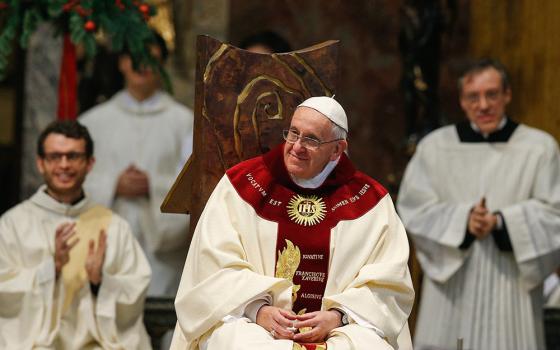
COMMENTARY
In an interview with National Public Radio this morning on the appointment of the newest batch of cardinals, NCR’s John Allen was asked what the new cardinals say about the church’s response to the sex abuse crisis.
Allen’s response was short and simple: “Pope Benedict believes the response to the scandal is not in sweeping change, but instead in what he calls spiritual rebirth.”
That answer recalls something the pope himself said Sept. 8.
It was barely noticed, but on that day the pope made perhaps his most significant (and most disturbing) statement about the church’s on-going sex abuse and cover up crisis.
“True renewal of the ecclesiastic community,” he said, “is the result less of structural changes than of a sincere spirit of repentance and an active path towards conversion.”
A Catholic news agency had this take on Benedict’s comment: “The solution to the problem of clerical sex abuse lies in a spirit of penitence and conversion, rather than a radical change of church structures, said Pope Benedict.”
And Agence France-Presse’s view: “Pope Benedict XVI says repentance is more effective than structural change within the Church to counter sexual abuse by priests.”
While the Pope’s repeated apologies to abuse victims are “front page news” across the globe, this remark was nearly ignored. Many victims and advocates, however, felt deeply distressed by the pontiff’s line-in-the-sand declaration that when it comes to the most devastating crisis in modern church history, Catholics could expect, at most, mere “tinkering around the edges.”
Such a decision inevitably prompts the question we at the Survivors Network of Those Abused by Priests hear so often, usually in plaintive but sometimes agonizing tones of voice:
Why? Why is the church hierarchy so intransigent on this scandal? Why won’t the Vatican even entertain any but the most minimal, procedural ‘reforms’ without looking more deeply or thinking more broadly?
There are, we believe, three basic theories.
“Lack of empathy” or “Too much testosterone”
This view was perhaps first expressed by noted author, filmmaker and frequent NCR contributor Jason Berry.
In his seminal 1992 book Lead Us Not Into Temptation, Berry writes that bishops “don’t have children. They do not know what it means to hold an infant with colic in late hours, or the elation wheh a child learns to walk. Their appreciation of these and the myriad other experiences that come with parenting is abstract, vicarious and minimal at best.”
This theory is tempting because it suggests a simple, common sense solution: admitting women and married persons into the priesthood. On the other hand, it doesn’t explain why so few nuns speak up when they suspect clergy sex crimes or why organizations of nuns (notably the Leadership Conference of Women Religious) say and do little or nothing about child sex abuse, by either their own members or by male clerics.
And we’ve seen no evidence, for example, to suggest that dioceses with female chancellors are any more proactive or forthcoming or sympathetic in child sex abuse cases than those with male chancellors.
“Lack of risk-taking” or “Too much bureaucracy”
Almost inevitably bureaucracies are structured to resist change.
This is especially true of an ancient, rigid, secretive, clerical institution in which the ordained are automatically given exalted status. And the men who aspire to and succeed at rising in this particular institution are inherently risk-averse. They are “company men,” not innovators or entrepreneurs.
These factors conspire to make the church hierarchy stunningly unwilling or unable to adapt to changes, even those which may seem dreadfully threatening.
Recall what New York grand jurors concluded in their 2003 investigation of the Rockville Centre diocese: “The Diocese [is] incapable of properly handling issues relating to the sexual abuse of children by priests.”
This theory fails, however, to explain why less hierarchical or ancient church structures -- like the Southern Baptist Convention -- also have shockingly troubling track records when it comes to abuse and cover up.
“Lack of integrity” or “Too much secrecy”
Assume that five priests share a rectory. None, of course, are permitted to have sex in any form. One masturbates. Another looks at porn. Another cruises gay bars. Another makes passes at women parishioners. The fifth spends an inordinate amount of time around girls or boys.
This theory, which could more bluntly be called the “everyone’s dirty” theory, holds that all five feel ashamed or vulnerable because each is violating their celibacy pledge. So none feel brave or comfortable enough to “rat” on his colleagues.
Remember, unlike school teachers, priests can’t suddenly go to work in another diocese if their peers ostracize them for reporting known or suspected sexual misdeeds. Nor can they go home at 5 p.m. each day to a loving life partner who comforts them. Just ask Tom Doyle or Jim Scahill or Tom Gumbleton: if a priest becomes a pariah, an already somewhat lonely life suddenly becomes even almost intolerable.
This theory may help explain why relatively few child molesting clerics are ever defrocked. Many are suspended, some walk away, but only a minority are formally laicized.
A bishop who is tempted to defrock a predator may fear that if all ties and sustenance are cut off, the predator may “sing like a bird” and reveal sexual or financial misconduct by his former colleagues to police, prosecutors, victims’ attorneys or the media. (This happened in a noteworthy New Jersey case a few years ago involving a notorious pedophile priest, Fr. James Hanley.)
On the other hand, however, this is a particularly depressing theory. It essentially says that almost all of the church hierarchy is either too corrupt and/or timid to take decisive action on the horror that most undermines the moral witness and perhaps ultimate longevity of the church itself.
There is, of course, a fourth view, often espoused by John Allen and church insiders.
It holds that each of these theories uses an inappropriate yardstick. Given the usual glacial pace of change within the church, these individuals argue that Vatican has, indeed, responded dramatically to the crisis.
Unfortunately, however, this theory collapses beneath the individual, lived reality of vulnerable children who are being abused and the wounded adults who are suffering now.
Surely few slaves felt consoled when told “On the next plantation over, the owner is even crueler.” And comparisons of how quickly Law resigned versus how slowly Galileo was “exonerated” don’t comfort suicidal grown ups or protect at-risk kids.
That Enron ripped off more individuals than Bernie Madoff may be factually true. It’s also functionally irrelevant.
This theory also fails to acknowledge that the Vatican “response” to the crisis has primarily been symbolic, not substantive.
The Pope talks about abuse -- belatedly -- and vaguely acknowledges "sins within," while apologizing to and meeting with a few victims. All of this is great public relations, but viewed in the cold light of day it’s just words.
More words, admittedly. More contrite words, certainly. But words, nonetheless.
And not one child is safer today because of these words.
Understanding why Benedict fiddles while the church and its children burn isn’t a mere parlor game. It is a key precursor to effective reform that can help heal the wounded and safeguard the vulnerable.
But unresolved disputes about root causes can’t paralyze us from taking the simple proven steps that history, psychology and common sense tell us will make at least a short term difference in ameliorating and preventing incalculable pain.
[David Clohessy is the director of the Survivors Network of Those Abused by Priests.]




